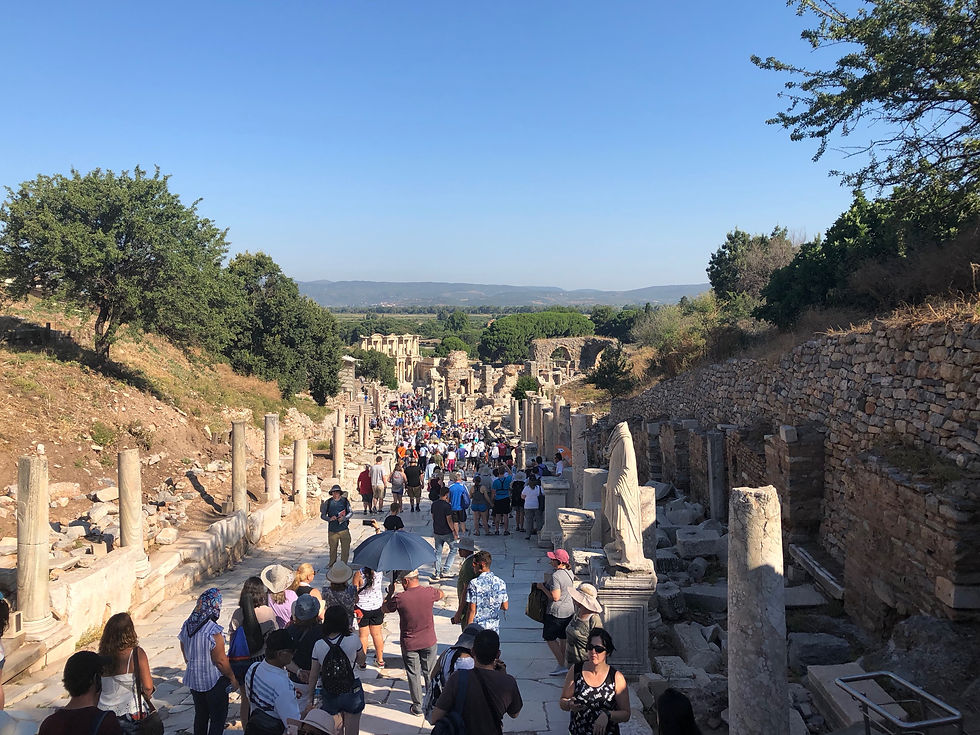‘Günaydın’* — Good Morning from Turkey
- Susan Nash

- Jul 15, 2019
- 3 min read
July 6, 2019, Kusadasi (Ephesus), Turkey — *Say ‘goony-den.’
I hadn’t known the tour would include a morning in Turkey, so I’ve added another country. We were welcomed at the pier by dancers and musicians. Everyone I know who’s been to Turkey loves it, but the politics of President Erdogan, the attempted coup in 2016, and fears about personal safety have hit their tourism industry very hard. So they go out of their way to welcome visitors.

Turkey’s population is around 80 million + 4 million Syrian refugees. Sixty-five percent are under 30... the average age is 28.8 years. With 20 million people, Constantinople — say con-STAN-tin-o-POLL-iss — is the largest city, followed by Angora (Ankara) and Izmir (Smyrna). Yes, they still say Constantinople where we say Istanbul. About 95% consider themselves Muslim (‘but not Islamic,’ our guide said), though they may not practice. Since Atatürk (Mustafa Kemal) in 1923, when the country became a democracy, church and state have been separated.
Turkey has tried unsuccessfully for 30 years to join the EU. It is surrounded by the most northeasterly little sliver of Greece... then Bulgaria, Georgia, Armenia, Iran, Iraq and Syria. ‘We need to remain allies with the United States,’ said our guide.
When we got off the bus, we ran the market gauntlet. I didn’t see any of our troop trying on belly-dancing outfits...

Our ‘Ancient Ephesus through the Ages’ excursion headed to the archeological site at Ephesus, which had been the capital of the Asia Minor parts of the Holy Roman Empire. First settled around 6000 BCE, it was colonized by early Greeks but reached its heyday around 0-300 AD under the Romans. It was the Roman Empire’s fourth largest city, after Rome, Alexandria and Antioch.
Amazingly, only 20% of the ancient structures have been excavated so far, and, according to archeological sonar, there’s another 80% underground waiting to be unearthed. The Turkish government is a main funder, along with the Austrian Archeological Institute, which began its digs here in 1895 with the permission of the Ottoman Sultan. Excavation has just begun on this bank...

But there is so much more to do...



The crowds....

... were on their way to the Library. So far, only the facade has been reconstructed, of original plus replacement parts.

I did not tamper with the sky color... this is what Greek sky looks like.

I did tamper with this shot...

This was not a theatre, per se, but a meeting place.

Turkey’s economy is based on tourism, olives and olive oil, fruits, cotton — think Turkish towels — and Turkish rugs. The rug industry has been suffering along with the rest of the economy. After our archeological tour, we stopped at a rug emporium — but not Aladdin’s — in the Selçuk village area.

We saw how silkworm cocoons become silk thread. The cocoon...

...goes into a vat of boiling water to soften up...

The woman swishes the cocoons around with her brush then draws up and collects the silk threads as they miraculously disengage from the cocoons... she consolidates them then puts them on a spinner.

We watched three women work on rugs that will take them months to complete. The dyes are all natural, vegetable. We were assured that they do not use child labor... and the women work only 4 hours a day.


Cutting off the excess thread from the knots...

We were served cider or tea, then the finished products.... all wool, or wool and silk, or all silk... were presented to us with great panache...


We were told we could walk on them with or without shoes... I went barefoot to appreciate the silk. There were many traditional or expected designs and colors. But these are my favorites...



No, I did not buy one. But many friends did. Here’s Ellen signing the back of the rug so when it arrives in Connecticut in 6-12 weeks, she will know it is the rug she picked and paid for, and not some other (inferior) one. Me? I bought a pillow cover.

Then, back to the boat to cruise to the next island: Patmos. #




Comments